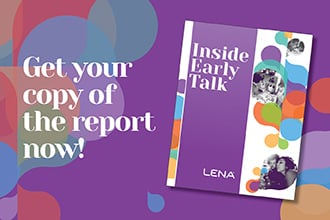In 2019, LENA reached the milestone of serving over 10,000 children in just one year. That was cause for celebration, but it was also a call to action.
When we had reached 10,000 children, when we had recorded tens of millions of conversational turns between those children and their parents and caretakers, and when we had partnered with hundreds of outstanding organizations, we realized just how immense a data set we had collected. More than that, though, we realized just how much tangible good could come from that data set.
Caregivers — parents and child care workers alike — so often rely on intuition when it comes to deciding in the moment what’s best for the children in their care. We want to see our data offer concrete guidance based on objective data. And more than anything else, we want to see that concrete guidance change adults’ habits for the better.
That’s the kind of thinking that set our newest report into motion. It’s called Inside Early Talk, and it’s  .
.
We don’t intend for Inside Early Talk to be an exclamation point on the data we’ve collected. To the contrary, this is a starting point. It’s our first foray into digging into this data on an aggregated scale.
Have we been able to land on some intriguing and definitive findings about early language environments already? Yes. Do we want these findings to prompt questions that will lead us to dig even deeper into the data and draw out still more findings? Absolutely.
This isn’t just a numbers game, and we’re not just speaking the language of statisticians. We want Inside Early Talk to make it easier than ever to translate big-picture science into individual action.
In short, children’s brains need more talk. What can caregivers do to ensure they’re getting that talk? Where do the opportunities and the challenges lie? What actions can policymakers, funders, and program implementers take?
What do we say in Inside Early Talk?
Finding 1: 40 conversational turns per hour is a new benchmark for caregivers.
Conversational turns are those back-and-forth interactions between a child and an adult — from speech-like, non-cry sounds in infants to full words and sentences in 2, 3, and 4 year olds. They’re simple, but they’re also incredibly important for a child’s brain development. Looking at this new data tells us there’s something particularly significant about reaching 40 turns per hour.
Finding 2: High-turn families demonstrate attainable patterns of talk.
After zeroing in on 40 conversational turns, we turned to the question of what “high-turn” families were doing to achieve that number.
It turns out that their behaviors, while impressive, are wholly attainable:
- They’re not talking nonstop. Rather, there are peaks and valleys throughout the day.
- Even during hours with more than 40 turns, they’re not talking for the whole hour.
- They’re successful because they double down. If they get one turn, they try to go for one more.
This is where translating research into practice comes into play. Adults may already have an inkling that they should be talking to the children in their care, but giving them data-driven goals makes improvement both easier to accomplish and more likely to actually happen.
Finding 3: Home settings are consistently higher in interactions than child care settings.
It’s undeniable, and even unsurprising, that children generally experience more conversational turns at home — 73% more. After all, that’s where they’re with familial caregivers, that’s where interactions with adults tend to be spread across fewer children, and that’s where conversational interruptions aren’t likely to occur as frequently.
In addition to policy resolutions, we need more immediate interventions — actions that both improve quality for individual children and add up to statistically significant improvements for all.
Finding 4: In child care, interactions are the lowest when they matter most.
In a 10-year longitudinal study we conducted in 2018, we concluded that the period between 18-24 months is a key window for adult-child language interaction. No other age range between birth and 3 years shows a greater correlation between conversational turns and verbal skills in middle school. Alarmingly, though, this is the precise window in which children in child care settings experience the least amount of back-and-forth interaction.
Finding 5: There are large disparities in the language environments children are experiencing in child care.
Every experience of each of the over 10,000 children whose early talk data contributed to Inside Early Talk is important. We don’t want that reality to get lost amid all the statistics. Even in classrooms that have high levels of back-and-forth interactions between adults and children overall, some children spend large portions of their day in relative language isolation.
Finding 6: The effects of COVID-19 reveal reduced turn taking in child care.
We’ve already told several stories about how our partners have found success amid the pandemic’s challenges. In this new report, we also face up to some of the stark realities. Among other things, we can point to an even more critical need to reduce child-to-teacher ratios, especially when teachers are facing new challenges or additional responsibilities.
What now?
At LENA, we’re more convinced than ever that early talk is our most scalable and cost-effective point of leverage for improving children’s academic futures. We also think that the case for investment has never been clearer. We’ve come out of the process of producing Inside Early Talk both optimistic and determined.
We want to reiterate that this analysis is a starting point, not a finish line. Greater collaboration and aggregation of early childhood data need to take place. That’s how we’ll come to understand the factors that drive differences in early language experiences. We also want to see LENA’s data inform policy decisions that increase equitable access to rich language environments for all children. And we want to encourage large-scale partnerships between organizations that are in the position to create a tipping point of impact.
We invite your to read and share Inside Early Talk. We also invite you to let us know what you think and what questions you have — and we mean that.
[webinar]





